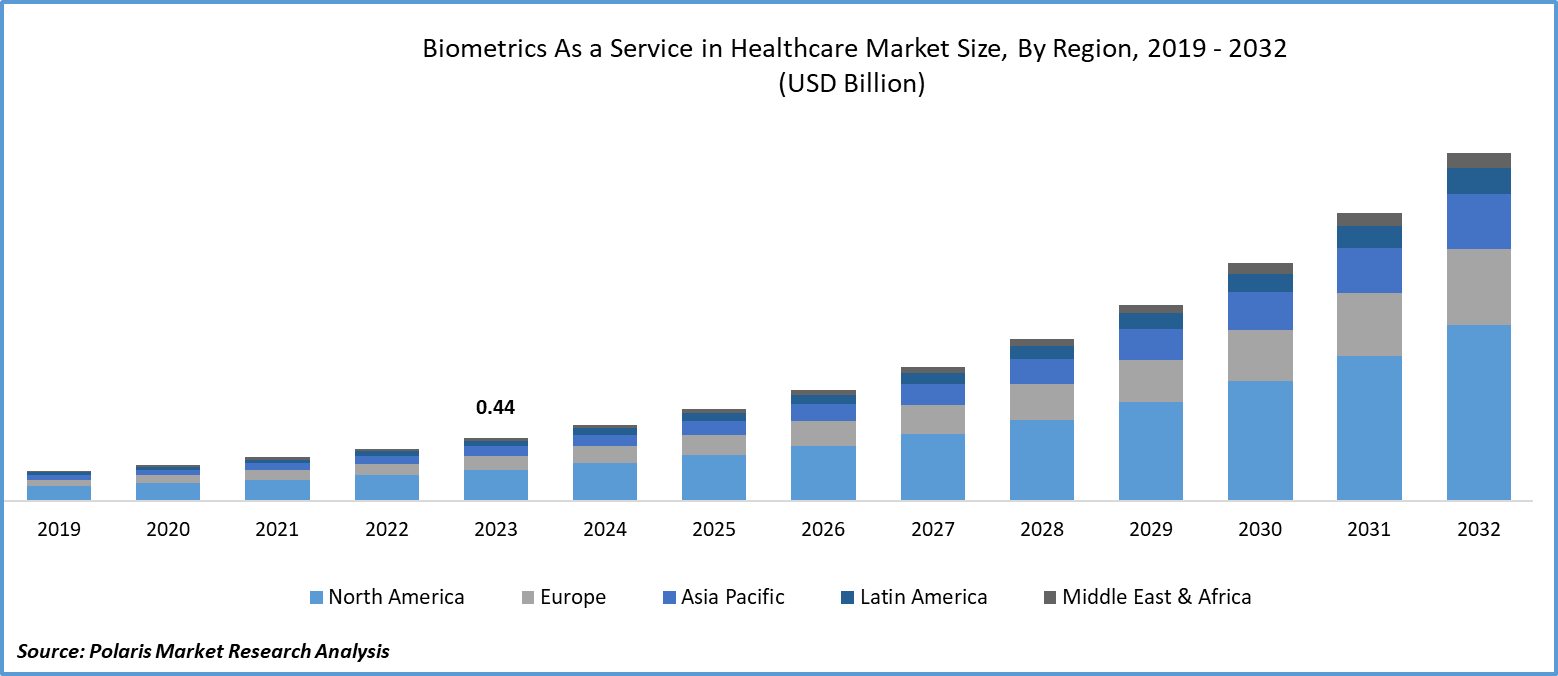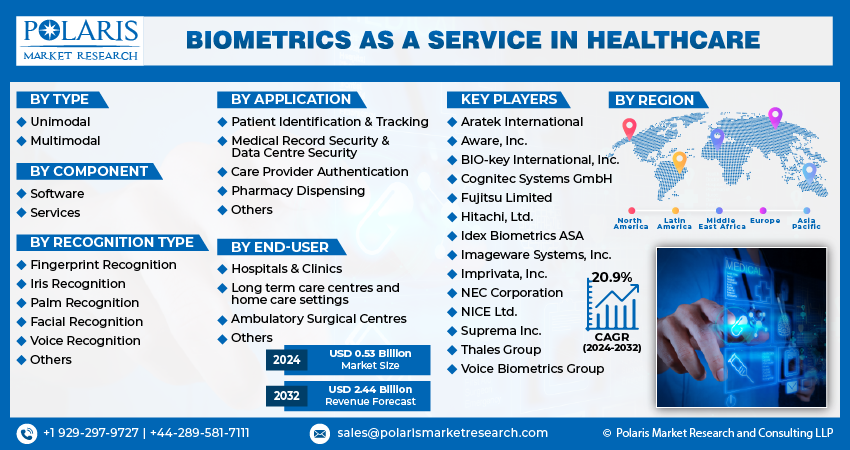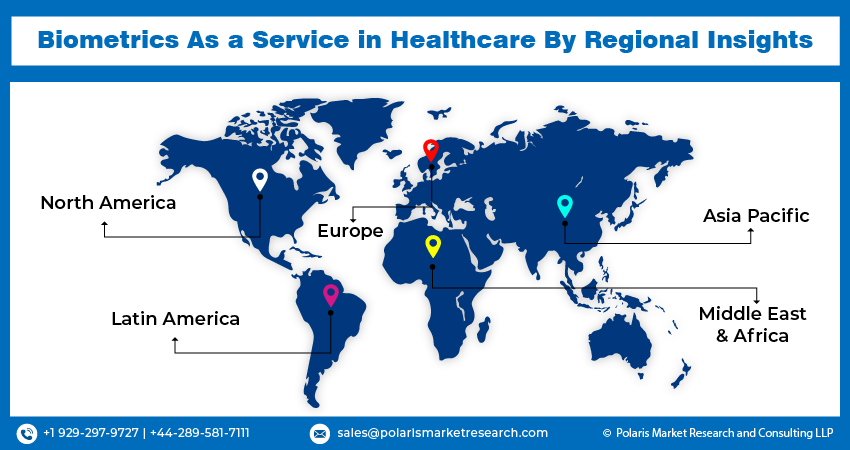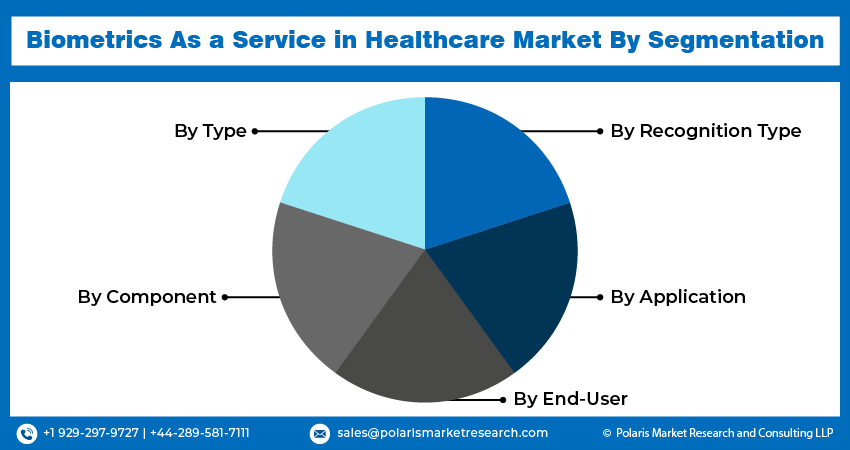
Biometrics As a Service in Healthcare Market Share, Size, Trends, Industry Analysis Report
By Type (Unimodal, Multimodal); By Component (Software, Service); By Recognition Type; By Application, By End-User; By Region; Segment Forecast, 2024 - 2032
- Published Date:Apr-2024
- Pages: 119
- Format: PDF
- Report ID: PM4880
- Base Year: 2023
- Historical Data: 2019-2022
Report Outlook
Biometrics as a Service in Healthcare Market size was valued at USD 0.44 billion in 2023.
The market is anticipated to grow from USD 0.53 billion in 2024 to USD 2.44 billion by 2032, exhibiting the CAGR of 20.9% during the forecast period
Biometrics As a Service in Healthcare Market Overview
Biometrics As a Service in Healthcare is emerging as biometrics may significantly improve healthcare by altering lives and revolutionizing the way medical services are provided. Patient check-in with biometric identification demonstrates its transformational power. For providing individualized and effective healthcare, biometric patient identification has become a vital instrument. Through the use of a Know Your Patient (KYP) procedure that includes biometric verification. The use of biometric wearables for secure authentication during remote visits is made possible by telemedicine, remote patient monitoring, and the Internet of Medical Things (IoMT). Controlled access in medical facilities enhances patient safety.

To Understand More About this Research: Request a Free Sample Report
- For instance, in February 2024, AI/ML Innovations Inc. launched the Micropayment Pilot Program, collaborating with TODAQ Micro and Health Gauge Biometrics to lead the integration of micropayments in the healthcare ecosystem.
Moreover, there are emerging trends in biometrics as a service in healthcare market due to integration of block chain in biometrics for enhanced data security. Artificial intelligence (AI) integration will grow further, resulting in more sophisticated and individualized healthcare solutions. Healthcare practitioners may give patients more individualized, data-driven treatment by fusing biometrics' precise identification with AI's insights and forecasts.
However, during COVID-19, biometric systems have come under scrutiny as a crucial piece of technology for patient screening, public safety monitoring, and early detection. Touchless biometric identification technologies such as iris recognition and face recognition emerged in healthcare during the pandemic for utilization in infectious disease prevention and control strategies at a rapid pace.
Biometrics As a Service in Healthcare Market Dynamics
Market Drivers
- Rising need for advanced biometrics
There is rising awareness of the need for advanced biometrics in healthcare to enhance patient safety and security by integrating artificial intelligence or a blockchain mechanism. This provides personalized solutions to create a patient-centric ecosystem in healthcare. Accurate patient identification is still a top priority in applications for healthcare management, including personal identification, attendance monitoring, matching patients to medical records, and deploying effective authorization and authentication systems in various healthcare settings.
- Rising adoption of Biometrics as service in healthcare market
Rising adoption of biometric use due to its affordability, cloud technology's ease of integration with healthcare services, and premium assurance and security are some of the reasons driving the market's expansion. Cloud-based biometrics are expected to replace the conventional paper-based record management approach. This is due to technological advancements in cloud infrastructure, significantly increasing the market share.
Market Restraints
- Patient data safety and security.
Biometric authentication systems keep private data about people, including their fingerprints or facial characteristics. This information might be exploited. Sometimes, people are mistakenly identified by biometric authentication systems, resulting in false positives. Systems for biometric authentication can be costly to set up and must be updated and maintained regularly to guarantee their efficacy.

Report Segmentation
The market is primarily segmented based on type, component, recognition type, application, end-user, and region.
|
By Type |
By Component |
By Recognition Type |
By Application |
By End-User |
By Region |
|
|
|
|
|
|
To Understand the Scope of this Report: Speak to Analyst
Biometrics As a Service in Healthcare Market Segmental Analysis
By Type Analysis
- The multimodal segment held the highest market share due to its ability to combine several biometric authentication techniques, including voice recognition, iris scanning, fingerprint, and face recognition, into a strong and adaptable solution for access control and identity verification by strengthening security and lowering the possibility of unwanted access to private patient information and healthcare facilities. This guarantees precise patient by multimodal biometrics which enhances the entire patient experience.
By Component Analysis
- The software segment accounted for the largest market share and is likely to retain its market position throughout the forecast period. Software solutions focus on patient data protection and precise identification verification. These software solutions include a wide range of applications, including identity management platforms, data encryption, and biometric authentication systems, allowing healthcare providers to protect patient data while guaranteeing easy and effective access for authorized staff. Moreover, software solutions have the potential to significantly reduce costs and increase scalability in healthcare operations, allowing for quick industry acceptance and integration.
- The services segment is expected to grow at the fastest growth rate over the next coming years on account of the rapid increase in improving patient engagement and experience, supporting innovation and agile development, facilitating seamless integration and interoperability, streamlining operations, and enhancing efficiency along with data management and security. The services segment is evolving with digital transformation to become more patient centric.
By Recognition Type Analysis
- ·The fingerprint recognition segment accounted for the largest market share due to accurate patient identification, leading to no more errors. It is a reliable and convenient method to identify the people in the healthcare ecosystem accurately. Fingerprint biometrics provide a dependable and user-friendly option for healthcare companies to ensure patient privacy, data security, and compliance. Fingerprint biometrics is a compelling alternative due to its scalability and affordability. In order to maintain patient safety and data integrity as the healthcare sector continues its digital transformation, the fingerprint market is well-positioned to be extremely important.
- The facial recognition segment is expected to grow at the fastest CAGR. This technique compares the identified face in a still or video frame with a human face stored in a database, serving as a rapid and effective verification mechanism. Since facial recognition technology doesn't need physical contact, unlike fingerprint or other security methods, it offers an automated, quick, and seamless verification experience, which is projected to drive demand for the market in the years to come.
By End-User Analysis
- The Hospitals and clinics segment dominated the market and is expected to continue leading over the forecast period due to secured access and control over sensitive patient data. Given the growing dependence on digital technology and the need to protect patient information, biometric solutions are now essential for improving security and productivity in healthcare settings. Clinics and hospitals are using biometrics to expedite patient check-in procedures while guaranteeing precise patient identification.
- The ambulatory surgical centres are expected to grow at the fastest CAGR over the forecast period due to their ability to provide easy and efficient access to patient’s medical history as well as maintain the patient’s data with security avoiding data breaches and complying with privacy concerns. As an alternative to hospital-based outpatient operations, ASC offers patients more convenient options with its state-of-the-art healthcare facilities, which are concentrated on offering same-day surgical care, including diagnostic and preventative procedures.
Biometrics As a Service in Healthcare Market Regional Insights
The North America region dominated the global market with the largest market share
The North American region dominated the global market with the largest market share due to the rising adoption and integration of technology by North American countries into healthcare. Biometrics in healthcare is used to ensure seamless patient experience in order to guarantee precise patient identification or to keep an eye on patients, and biometrics are utilized in hospitals, physician offices, and other healthcare settings. Applications may involve patient record storage or access restriction. Biometrics can also be used for remote diagnosis and electronic prescriptions, and they are being developed for use in patient monitoring outside of conventional healthcare settings.
The Asia Pacific region is expected to be the fastest-growing region with a healthy CAGR during the projected period, owing to the expansion of biometrics as a service in the healthcare industry is the widespread use of mobile devices in this region. Rising government initiatives for an efficient healthcare system and a rise in the desire for affordable ways to acquire enhanced biometric capabilities. Organizations may better manage transactions, inventory, cash flow, billing, and payroll by integrating biometrics with internal systems.

Competitive Landscape
The biometrics as a service in healthcare market is anticipated to witness competition due to several players' presence. Major biometric service providers in the market are constantly upgrading their technologies to stay ahead of the competition and to ensure patient data safety and security. These players focus on accessibility, safety of the data base of patients to acquire a competitive edge over others and capture a significant market share.
Some of the major players operating in the global market include:
- Aratek International
- Aware, Inc.
- BIO-key International, Inc.
- Cognitec Systems GmbH
- Fujitsu Limited
- Hitachi, Ltd.
- Idex Biometrics ASA
- Imageware Systems, Inc.
- Imprivata, Inc.
- NEC Corporation
- NICE Ltd.
- Suprema Inc.
- Thales Group
- Voice Biometrics Group
Recent Developments
- In February 2024, b.Well, the digital healthcare platform has secured $ 40 million in funding to launch secured telehealth along with VerifyNow, who launched the platform.
- In March 2024, Lyric Health selected Reperio Health as an exclusive partner for At-home Biometric Health Screenings to more than 6 million people across Lyric’s network.
Report Coverage
The biometrics as a service in healthcare market report emphasizes on key regions across the globe to provide better understanding of the product to the users. Also, the report provides market insights into recent developments, trends and analyzes the technologies that are gaining traction around the globe. Furthermore, the report covers in-depth qualitative analysis pertaining to various paradigm shifts associated with the transformation of these solutions.
The report provides detailed analysis of the market while focusing on various key aspects such as competitive analysis, type, component, recognition type, application, end-users, and their futuristic growth opportunities.
Biometrics As a Service in Healthcare Market Report Scope
|
Report Attributes |
Details |
|
Market size value in 2024 |
USD 0.53 billion |
|
Revenue forecast in 2032 |
USD 2.44 billion |
|
CAGR |
20.9% from 2024 – 2032 |
|
Base year |
2023 |
|
Historical data |
2019 – 2022 |
|
Forecast period |
2024 – 2032 |
|
Quantitative units |
Revenue in USD billion and CAGR from 2024 to 2032 |
|
Segments covered |
By Type, By Component, By Recognition Type, By Application, By End-User, By Region |
|
Regional scope |
North America, Europe, Asia Pacific, Latin America; Middle East & Africa |
|
Customization |
Report customization as per your requirements with respect to countries, region and segmentation. |
FAQ's
The global Biometrics as a service in healthcare market size is expected to reach USD 2.44 billion by 2032
Key players in the market are Fujitsu Limited, Hitachi, Ltd., Idex Biometrics ASA, Suprema Inc., Thales Group
North America contribute notably towards the global Biometrics As a Service in Healthcare Market
Biometrics as a Service in Healthcare Market exhibiting the CAGR of 20.9% during the forecast period
The Biometrics As a Service in Healthcare Market report covering key segments are type, component, recognition type, application, end-user, and region.

